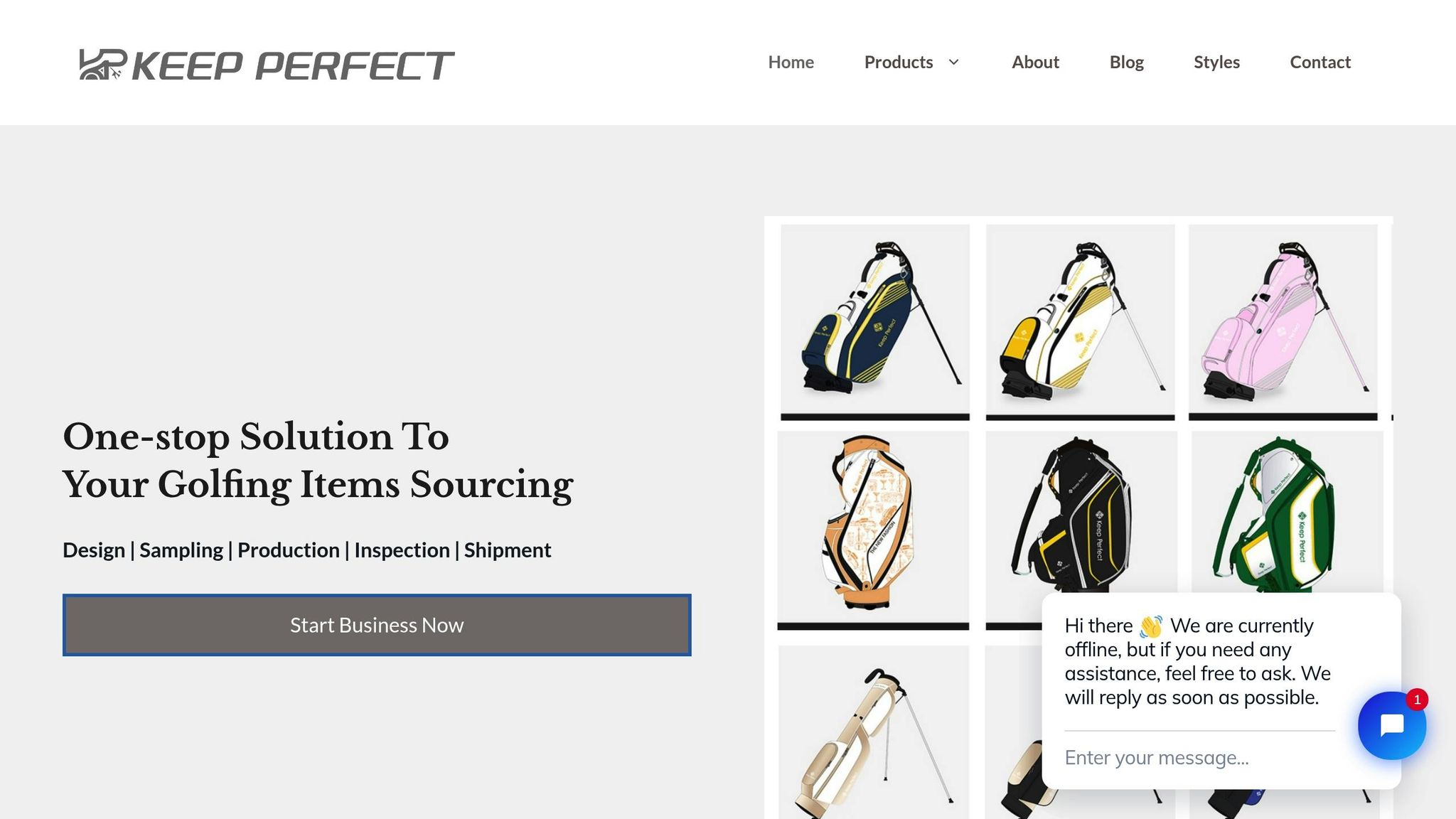Eco-friendly golf bags are transforming the game by using recycled and natural materials, reducing waste, and cutting energy use. Here’s what you need to know:
- Materials: Bags now feature recycled PET (rPET) fabrics, repurposing plastic bottles, and biodegradable components.
- Manufacturing: Companies like BIG MAX and Keep Perfect Golf Gear are integrating solar power, water recycling, and waste reduction into production.
- Performance: Modern designs match traditional bags in durability, weight, and weather protection.
- Market Impact: Sales of eco-friendly golf bags in the U.S. grew by 217% from 2021 to 2024, driven by younger golfers prioritizing sustainability.
Quick Fact: A single Sun Mountain Eco-Lite cart bag repurposes about 25 plastic bottles while maintaining professional quality.
These advancements show that high-performance golf gear can also be planet-friendly. Keep reading to explore the materials, methods, and success stories behind these sustainable innovations.
Where Are Sun Mountain Golf Bags Made? – The Golf Xpert

Materials Used in Eco-Friendly Golf Bags
Eco-friendly golf bags are now crafted using materials that aim to reduce waste and environmental harm while still delivering durability and performance. These designs focus on minimizing their footprint without compromising quality.
Recycled PET Fabrics
Recycled PET (rPET) fabric transforms plastic waste into durable material while using 75% less energy compared to creating new plastic from scratch. For example, Jones Golf Bags‘ R-series is made entirely from recycled ripstop PET fabric, showcasing how recycled materials can meet performance needs. Alongside rPET, other natural materials are also being integrated into golf bag designs.
Natural and Biodegradable Components
Organic textiles and biodegradable materials are also being used to further reduce the environmental impact of manufacturing.
Here’s how rPET compares to virgin polyester in terms of environmental savings:
| Environmental Factor | Reduction vs. Virgin Polyester |
|---|---|
| Energy Usage | 33–53% less |
| Carbon Emissions | 65% fewer |
| Water Consumption | 90% less |
These numbers highlight the tangible benefits of shifting to recycled and natural materials.
Environmental Impact Numbers
The production of eco-friendly golf bags delivers measurable environmental advantages. For instance, the rPET market was valued at $54.7 billion in 2022 and is expected to grow beyond $80 billion by 2028.
Sun Mountain’s Eco-Lite bags provide a clear example of how recycled materials are utilized:
- Cart bags repurpose about 25 plastic bottles (20 oz each)
- Stand bags use approximately 20 plastic bottles (20 oz each)
- Through a partnership with 1% for the Planet, they support river conservation efforts via Montana Rivers, Inc.
Currently, rPET makes up about 15% of polyester fibers used in textiles and apparel. This growing adoption signals a shift toward more responsible manufacturing practices in the industry.
Success Stories in Production
Keep Perfect Golf Gear is leading the charge in eco-friendly golf bag manufacturing by integrating solar power, closed-loop water recycling, and waste reduction into their production process. These efforts highlight their commitment to producing high-quality products with minimal environmental impact.
Keep Perfect Golf Gear‘s Green Practices

The company’s facility has achieved impressive milestones:
- Solar energy now meets 30% of their power requirements.
- Closed-loop water recycling has reduced water consumption by 40%.
- A recycling program that processes 85% of production scraps, diverts 91% of waste from landfills, cuts carbon emissions by 62%, and repurposes 4.3 million plastic bottles annually.
Additionally, a $2.5 million investment in research and development resulted in the creation of tear-resistant recycled fabrics that match the durability of nylon. These advancements are influencing sustainable practices across the industry.
Current Market Examples
Other companies are also stepping up with innovative approaches. VESSEL partnered with Dow Chemical in November 2023 to create luxury golf bags featuring LuxSense™ Silicone Leather. This material eliminates volatile organic compounds (VOCs) and has earned PAS 2060 carbon neutrality certification.
BIG MAX has introduced a "one-tree-planted" initiative, where a tree is planted for every electric trolley sold, further promoting sustainability.
Sun Mountain launched its Eco-Lite Stand Bag in August 2024, made from 89% recycled materials. This bag is 15% lighter than previous models and features a water-repellent treatment that reduces cleaning water use by 40%.
The market’s response has been overwhelmingly positive. Sales of eco-friendly golf bags in the U.S. have surged by 217% between 2021 and 2024. Younger golfers, in particular, are driving this trend, with 68% of players under 35 prioritizing sustainability when choosing products.
sbb-itb-4fa7e8b
Quality and Function
Weather Protection and Longevity
Sun Mountain’s WeatherMax fabric, crafted from bundled filaments, provides strong resistance to UV rays and mildew. Paired with sealed seams and waterproof zippers, it ensures complete protection against moisture. These features are designed to improve durability and user satisfaction.
User Experience
Modern eco-friendly golf bags have addressed past concerns about weight through thoughtful design. For instance, the Sun Mountain Eco-Lite stand bag weighs only 4 pounds while incorporating elements from award-winning designs.
MNML Golf has introduced sustainable designs with practical features:
| Feature | Benefit |
|---|---|
| Magnetic Closures | Prevents zipper failures |
| Solar-Powered Charger | Allows on-course device charging |
| Insulated Cooler Pocket | Keeps beverages at the right temperature |
| Velour-Lined Straps | Enhances carrying comfort |
The Minimal Golf Terra SE1 Stand Bag is another example of efficient eco-friendly design. It includes seven exterior pockets, two interior compartments, and a dedicated rangefinder pocket, all while maintaining a weight of just 5.7 pounds. These features combine functionality with sustainability, offering performance comparable to traditional bags.
Performance Comparison
Eco-friendly golf bags are proving to perform just as well as traditional options. The MNML Golf Gaia TE1 Cart Bag, for instance, features a 14-way top divider system and ample storage while weighing 7.4 pounds – similar to premium standard bags. Sun Mountain, known for its history of innovation like the kickstand design, showcases its expertise in the Eco-Lite series, available in six color choices. Manufacturers are also focusing on durability, using magnetic closures and replaceable parts to extend the lifespan of their products and minimize environmental impact.
Next Steps in Golf Bag Design
Exploring New Materials and Features
The golf bag industry is making strides in sustainable material options, experimenting with alternatives like Piñatex, Spinnova’s microfibrillated cellulose, Econyl, cork leather, and Tencel. These materials provide added durability, natural water resistance, and help lower environmental impact.
For instance, recycling 10,000 tons into Econyl saves 70,000 barrels of crude oil and cuts 57,000 tons of CO₂ emissions. Cork leather naturally resists water, while Tencel, with 50% greater absorbency than cotton, requires fewer resources during production.
Shifts in the US Market
In the U.S., consumer interest is leaning toward eco-friendly purchases. This shift is driving demand for products with environmentally conscious features, such as:
| Feature | Environmental Impact | Consumer Benefit |
|---|---|---|
| ECOPAK Material | Made from 100% recycled polyester | Waterproof, American-made |
| Recycled Cotton | Saves 202,000 gallons of water per ton | Combines sustainability with comfort |
"As a designer, there’s that double-edged sword of how cool it is to design stuff and put new products out, but you’re also in theory just creating more waste then, too."
– Ben Leibham of Renu Disc Golf
Keep Perfect Golf Gear’s Vision
Keep Perfect Golf Gear continues to lead with its focus on sustainability. The company is expanding its use of recycled materials, including golf bags crafted from 100% recycled ripstop fabric made from single-use PET bottles. They’re also incorporating ergonomic features tailored for active lifestyles. This approach reflects their dedication to balancing environmental responsibility with high-performance design.
Conclusion
Eco-friendly golf bags are changing the game, driven by increasing environmental awareness and the push for more sustainable options. Brands are showing that recycled materials can offer both durability and strong performance while minimizing environmental harm.
Take Sun Mountain’s Eco-Lite series as an example. Each bag in this line is made using about twenty-five 20-ounce recycled plastic bottles. This highlights how recycled materials can be used to create high-quality products without sacrificing functionality.
These efforts show that embracing environmentally conscious practices doesn’t mean giving up on quality or performance. This shift signals a future where sustainability and top-tier performance go hand in hand, setting a new benchmark for golf equipment.
FAQs
What are the environmental advantages of using recycled PET (rPET) fabrics in golf bags over traditional materials?
Recycled PET (rPET) fabrics offer significant environmental benefits compared to traditional materials like virgin polyester. Producing rPET uses 85% less energy, generates 65% fewer emissions, and consumes 90% less water, making it a much more eco-friendly option.
Additionally, rPET helps repurpose plastic waste, reducing the amount of plastic that ends up in landfills and oceans. By choosing golf bags made with rPET, you’re supporting sustainable practices while contributing to a cleaner planet.
Are eco-friendly golf bags as durable and weather-resistant as traditional golf bags?
Eco-friendly golf bags are designed to meet high standards of durability and weather resistance, comparable to traditional options. Many manufacturers use recycled fabrics, organic textiles, and biodegradable materials that are treated to withstand wear and tear, as well as adverse weather conditions like rain or high humidity.
While performance can vary depending on the brand and specific materials used, modern eco-friendly bags often include features like water-resistant coatings and reinforced stitching to ensure longevity. Choosing a sustainable golf bag doesn’t mean compromising on quality or functionality – it means making a choice that benefits both you and the environment.
How are companies making golf bag production more sustainable?
Companies are adopting innovative approaches to make golf bag production more eco-friendly. Many are using recycled materials, such as fabric made from plastic bottles, to reduce waste. Others are incorporating organic textiles and biodegradable components to minimize environmental impact.
Additionally, manufacturers are focusing on improving their overall sustainability practices, such as reducing energy consumption during production and sourcing materials responsibly. These efforts not only help protect the environment but also align with the growing demand for greener options in the golfing community.

